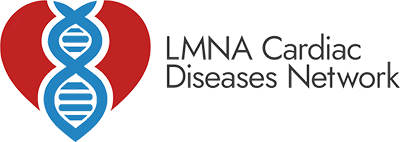What is PSIDER-Heart?
PSIDER-Heart is a research project in which various scientists and patients work together to understand more about inherited heart muscle diseases (also called cardiomyopathies) and to find out whether these diseases can be cured with new technologies.
Inherited cardiomyopathies are a group of disorders caused by mutations in genes. Current treatments focus on symptom relief. No cure is available yet. Promising gene editing techniques might help to develop a curative treatment.
To achieve this ultimate goal, a curative treatment, a lot of research is needed. Biological, medical as well as ethical and social issues are to be explored. Therefore a collaborative effort of all stakeholders is needed.
LMNA heart disease is one of the studied diseases
The PSIDER-Heart project focuses on inherited heart muscle diseases associated with Phospholamban (PLN) and Lamin A (LMNA) mutations. These mutations in pieces of the human DNA (also called genes) cause severe disease in a significant patient population.
Models of the human heart
The researchers want to get a better understanding on how gene mutations cause heart diseases. Therefore the condition and contractions of heart cells are studied in heart models. Such models are made in a laboratory of so-called induced pluripotent stem cells (in short: iPS-cells). These cells can be made from any human cell and transformed into other types of cells. In this case heart muscle cells. The heart models resemble a human heart but they are not the same as a human heart. They can contract, have chamber-like structures and can be kept alive for a few months by providing them with rich nutrients. But the heart models have no heart chambers and valves as in real human hearts. The models give researchers the opportunity to study differences between healthy heart cells, heart cells with different mutations and the effects of changing the DNA in cells without having to use real human hearts.
Changing DNA with new gene editing techniques
Within this project two gene editing techniques are being explored: CRISPR-Cas base-editing and CRISPR-Cas prime-editing. With these techniques DNA can be altered at particular locations.
CRISPR-Cas9 is the precursor of these techniques. This technique made it possible to repair various errors in genes. It is a kind of toolbox that consists of different parts: one part can detect the error in the gene. Then another part comes into action. This part is like a pair of scissors. It cuts the DNA at the site of the error and scientists can then ‘paste’ a correct donor DNA template in the DNA-code. But this method is not suitable for heart cells. The other mentioned techniques are newer and provide for a rewriting tool, which could be applied in heart cells. An additional advantage is that these techniques cut the DNA helix only partially, whereas CRISPR-Cas9 breaks the DNA-helix completely. This lack of DNA breaks decreases the risk of unwanted mutations or side effects.
CRISPR-Cas base editing allows researchers to make a single change in a DNA-code. A DNA-code consists of parts called bases. If there is an incorrect base in the DNA, base editing fixes the error in the code by turning the false base into the correct base.
CRISPR-Cas prime-editing works almost the same, but with this technique it is possible to correct a larger part of the DNA-code.
Since there are over 350 different mutations in the LMNA gene, it may differ for specific LMNA mutations whether either CRISPR-Cas base-editing or prime editing might be the best technique to correct them.
It is crucial to determine which technique works the best in particular cases and whether this technique is safe and effective for use in people eventually.
Laboratory tests in cells
First the techniques are tested in iPS-cells with LMNA mutations in a dish. The next step is to test the gene editing techniques on human heart slices, mainly obtained from diseased hearts of people who have undergone a heart transplant, sometimes from other surgical procedures. These people have given informed consent.
Tests in laboratory animals
After testing in cells the most successful method will be selected and then tested on mice. Scientists will try to bring the gene therapy into the heart cells. A kind of vehicle is necessary to accomplish that. Unharmful viruses or little vesicles could function as such a vehicle. When the testing in mice proves to be successful the researchers will run tests in pigs. Only when all signs are green, one could think of a ‘first-in-human study.’ This is a study wherein a treatment is tested in humans for the first time. (also called: phase I study). Such a study may involve risks even though all previous tests were successful. Who would be eligible for such a study? A question that cannot be answered yet.
Ethical issues of gene therapy for LMNA heart disease
Researchers also explore the ethical and social issues in this development process, through in depth stakeholder interviews. Because ethical and social questions clearly play a role in developing a gene therapy. If there is gene therapy, would it be available to all people who could benefit from it? What will it cost? And how high are the risks? Difficult questions to answer because there still are a lot of uncertainties and not all the risks are known yet.
How long will it take to develop a cure for LMNA heart disease?
It takes a lot of effort, time and money to develop a safe and curative gene therapy for LMNA heart disease. The PSIDER-Heart project will last until October 2027. It is difficult to say what results will be achieved by then. Researchers will have learned a lot, but actually realizing a gene therapy that cures people with LMNA heart disease may take longer.
Het Erfocentrum, the Dutch information centre on heredity, wrote this text under supervision of the PSIDER-Heart projectleaders. PSIDER-Heart is part of a program which is established and financed by ZonMW.
